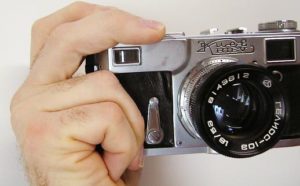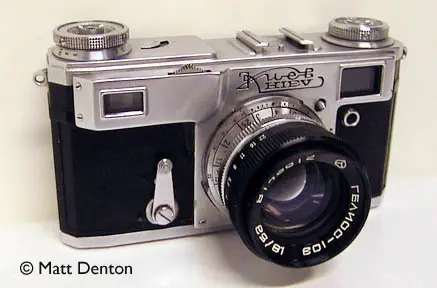- Produced 1947-1987 (1963) Arsenal, Kiev, Ukraine
- Film type 135 (35mm)
- Picture size 24 x 36mm
- Weight 1lb, 9.1oz (711.6g) with Helios-103
- Lens Arsenal Helios-103 53mm 1:1.8
- Focal range .9m to infinity
- Filter size 40.5mm threaded, 42mm slip-on
- Shutter metal curtain (whisper quiet!)
- Shutter speeds B, 1/2-1/1250 (yes, that’s right)
- Viewfinder coupled rangefinder
- Exposure meter none
- Self-timer
- Accessory shoe, PC sync connection
Overview
I’d like to say I bought this to keep my other Kiev company while it was quickly becoming surrounded by FEDs but that’s not entirely true (it predates my little FED collection in fact). Truth is that I’d been hearing so much about the quality of the Helios-103 (sometimes referred to as Gelios-103) lens as the Contax-mount normal lens of choice that I had to see for myself. And since the lens alone is not only a little hard to come by, but compares favorably to the price of the lens with a camera attached, I thought it was a little silly not to go ahead and spend the $30 plus shipping for a nice working 4a with Helios…
So the 4a is essentially the same as the 4 but without the uncoupled selenium meter. Lacking that feature it’s slightly sleeker in profile but less classic-looking if that makes sense. Feels nice in the hands though. And instead of the common Jupiter-8 lens it sports a Helios-103 53mm 1.8 which is bigger, faster and reportedly sharper than the Jupiter-8 but I haven’t used it enough to be able to tell the difference. I just know that among serious Kievaholics the Helios-103 is the normal lens of choice. It’s a little larger, with larger glass, and though it seems more ruggedly constructed, having taken both it and the Jupiter-8 apart, I think they’re both great lenses. It’s nice to have the extra fraction of a stop though, if you like available light photography like I do.
(FWIW, I particularly like the LTM Jupiter-8 which also seems a little better constructed than the Contax-mount version. You’ll find it as the standard lens on the Zorki-4.)
Now, I’m not positive but I think the Helios-103 was actually the standard lens for the later Kiev-4AM and 4M, which were slightly redesigned versions of the 4A and 4, so that would make this a kind of timeline hybrid. No matter to me, I’m no purist! It looks good, feels good, works well, takes nice pictures. The rest is just fluff, no?
SO like I said before I won’t bore you with the story of how at the end of WWII the Russians took the Carl Zeiss camera dies and machinery from Jena back to Kiev and converted the Arsenal there into a camera factory, churning out Zeiss Contax clones…it’s a good one though, and you can read about it by following some of the links below.
Like the 4, this is a heavy metal camera with a surprisingly quiet shutter. Almost as quiet as the Copal on my Yashica Electro, believe it or not. The rangefinder on the Contax is legendary, note the extreme distance between the windows, supposedly helping make it one of the most accurate rangefinders ever, in addition to being one of the first with a combined rangefinder/viewfinder window. (Note that this wide window spacing also makes it tricky to hold properly – there is a ‘Contax hold’ you use with these so you don’t cover that window with your fingers, see below.) While this is not an actual Contax it’s as close as I ever intend to get, and yes the rangefinder is spot on after 40 years.
Repairs
The test roll showed the exposure all over the map, I thought it was just me being rusty with my exposure guesstimation, but closer inspection after the fact revealed a crooked shutter curtain, caused by a sprocket-hole-sized bent PIECE OF FILM! It had found its way into the plane of the curtain and not only hindered its movement but made it lopsided. I took the piece of film out with a tweezer, and while verifying the shutter speeds against my Kiev-4 it gradually corrected itself both in verticality and speed (which was initially off as well) after firing it 20-30 times on various speed settings. Now they’re both pretty much in tune with each other. This is a testament to both the resiliency and longevity of the Contax-style shutter as well as its fragility. NOTE that the piece of film may have come from my homemade takeup spool, an Ilford film cassete spool with the nub cut off. (PS if you make one that way you have to trim the film leader to fit the slot.)
Extra Credit
See the Kiev 4 page for details on how to make the case more user-friendly!
Tips & Tricks
Rule one for rangefinders is of course remove the lens cap! Rule two for this one is try not to lose the takeup spool. If you do, though, see link below on how to fabricate a replacement from a used 35mm cassette (works on any Zeiss type camera, a Contaflex for instance).
Now, there’s a thing about Kiev / Contax – the rangefinder windows are so far apart you actually have to hold the camera differently to avoid putting your finger on the window. It’s called the ‘Contax Hold’ and it goes like this:

Basically you focus with your middle finger and shoot with your index, while keeping your other two fingertips away from the window. Takes a little practice but you’ll get used to it in no time.
The tripod mount on the Kievs isn’t the standard western 1/4″ mount, but a larger 3/8″ one like the head mount on a Bogen. Adapters are available but may take some looking.
Another little funny thing, you manually set the film counter to 24 or 36 when you are ready to start shooting, then it counts backwards to zero to let you know how many pictures you have left. This is true not only of several cameras of the era (Argus C3, Kodak 35) but of many FSU (Former Soviet Union) cameras in general, I find. I also find that I never remember to do this and so with cameras like this rarely have any idea what exposure I’m on. It’s annoying.
There’s a popular saying about playing Russian Roulette when you’re buying an FSU-made camera, the quality varies wildly depending on how much Vodka the workers had imbibed that day at the factory (or how honest the Ukranian seller is). I think that’s true to some extent – there was once a quota system that emphasized quantity over quality – but I believe the models from the 60s tend to be fine examples of solid workmanship, and if you’re careful to buy from a reputable seller you’ll do fine.
Related Links
- A great Kiev 4 page with all you wanted to know and more, including a manual in english
- Sovietcams.com, a nice site with specs on various Russian cameras including the Kiev 4
- The difference between the Contax III and the Kiev 4
- And even though it’s not really a Contax, this nice Zeiss Contax info site is great
- The one at Cameraquest is even better
- If you lose the takeup spool or get one without, Mike Elek has an easy way to make a replacement
- AND, while supplies last, you can get new old stock Helios-103 lenses for only $35 through RafCamera
